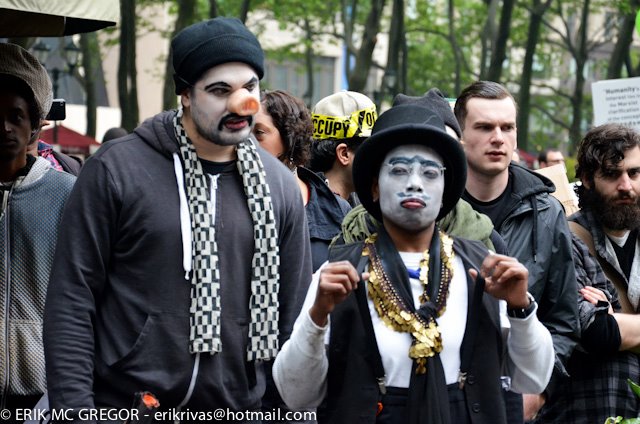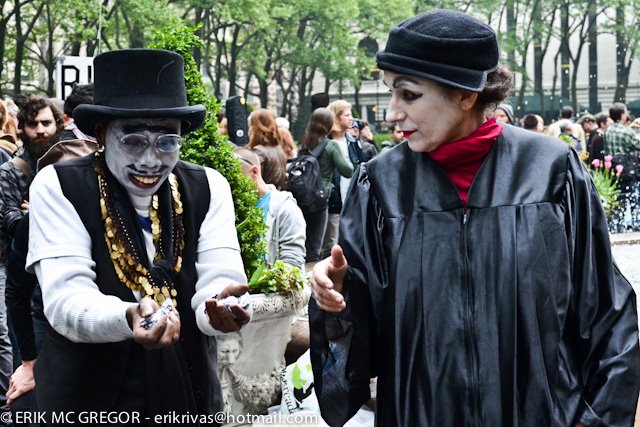@amabirch
Special to Boldaslove.us by Ama Birch
On May 1, 2012, I participated in the New York City Occupy Wall Street May Day Arts event in Bryant Park as an actor in the Theater for the 99% ensemble. The French acting troupe Le Théâtre du Soleil’s collaborative techniques were utilized to create a silent-play with musical accompaniment developed out of a Commedia dell’Arte mask workshop. As an ensemble we created the narratives for a short theatrical performance that was demonstrative of how the 99% supports the 1%. It is my fear that the ensemble of which I was a member of created a theatrical piece that reinforced negative stereotypes regarding gender, race and class and presented a homogenous group of protesters as representational of the Occupy Wall Street movement.
I played a whiteface, clown character (above) that I created during a two weekend Theater for the 99% workshop who is called Ray Pierre. He is a Rich “Uncle” Pennybags character who selects henchmen to protect him, underpays and fires hard-working employees, takes away a family’s home, teaches farmers how to use fowl smelling growth increasing pesticides on produce, and who eventually the 99% kills with a mountain of trash.
As an African-American actress, I was able to play the villain and one of the principal characters. During the workshop I was determined as an actor not to be an auxiliary character who was not intrinsic to the story of the Occupy Wall Street movement, the United States of America’s history, and the play we were creating collaboratively. In addition, I did not want to portray a victim in the play. Ray Pierre represented the establishment: the media, the politicians, the bankers, and corporate America. In hindsight I wonder why the director desired a whiteface, clown aesthetic on a play that reflected a movement that is made up of so many diverse races, genders, and classes. Is it possible that my performance as Ray Pierre was reinforcing a stereotype that the only way one can be part of the 1% is to be white and male?
One of the most amazing ironies was that Ray Pierre is also a victim in the story we told. At one point in the play, he claims that a woman who was part of the 99% has robbed from him. In that scene, he conveys through gesture to the judge, Ray Pierre’s friend, that the woman stole money from him, which is a lie. The irony is that the mainstream media in the United States of America has a propensity to present images of African-Americans and other minority groups as villains who are strange and scary. Concurrently, the mainstream media has created an image of the Occupy Wall Street movement where it appears that the true victims and cultural warriors in the battle for essential human rights and income equality in the United States of America are mostly Caucasian-Americans. This is done through the images and news stories the mainstream media selects to publish and air regarding the movement when it does choose to publish or air stories regarding the Occupy Wall Street movement. The irony of this type of representation is that the more the movement is portrayed in this fashion the less appealing it seems to be to many minority groups who might have mutual interests.
Ama Birch with Alia Thabit (r) as The Judge
I visited Zuccotti Park on the fourth day of the occupation for the first time. As a American facing economic difficulties, I felt that the Occupy Wall Street movement was addressing issues that are close to my heart: healthcare, housing, access to food, education and wealth redistribution. Corrado Gini, an Italian economist, created a mathematical system to measure the disparity between the rich and poor in a country. It is called the Gini Coefficient. How do we redistribute the wealth in a society where one group of people are disproportionately controlling the wealth, resources, and power in that same society? How do disenfranchised minorities obtain access to wealth, property, and political power if the establishment is a homogenous group that dictates what is right, what is wrong, and that seems to villanize difference as weird and creepy?
The aesthetic of whiteface and clowning in theater and art is a complicated issue, and I like to believe that a minority in North American society does not need to wear a metaphorical or literal white mask to be relevant and seen as not different in the society that we live in. It would be horrible to think that only wealthy Americans, indifferent to race, are rightfully entitled to healthcare, education, housing, and organic foods while they are also creating and regulating the policies that reinforce a discriminatory system based on race, gender and class all the while claiming to be victims within the same exact society. However, my experience with the Theater for the 99% makes me feel that this just might be the case.
Ama Birch is a NYC-based actor, writer, director, producer, and filmmaker. Visit her site or follow her on Twitter.



